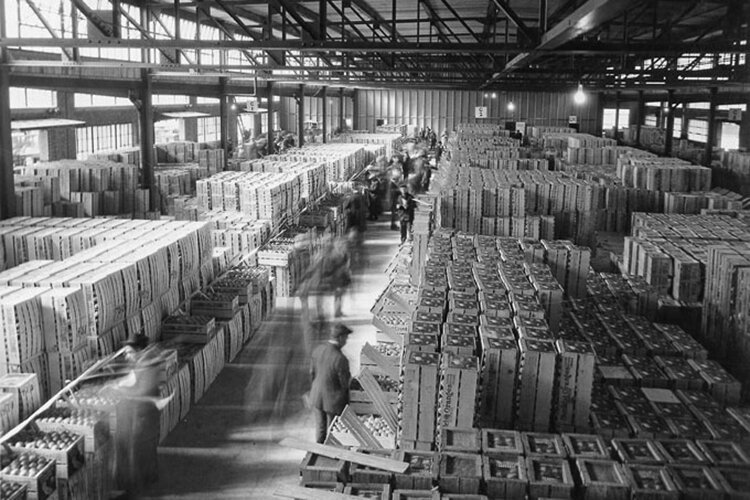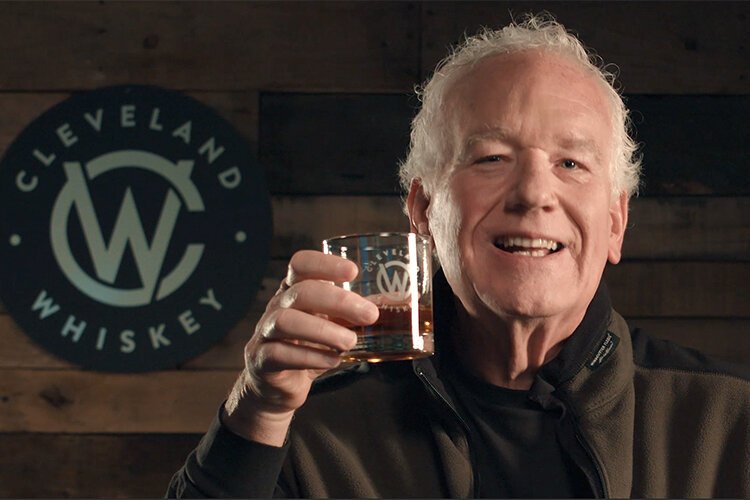Where to Buy Bulk Rice in Cleveland, Ohio
Back in March 2014, when Tom Lix was celebrating the one-year anniversary of Cleveland Whiskey, the company was taking off and was producing 4,000 bottles of whiskey a week. Today, Cleveland Whiskey produces about 85,000 bottles of 10 different whiskies a year with a staff of 16 and distributes its products to 16 U.S states as well as Europe and Asia.
"In 2019, we turned out first profit," says Lix. "And in 2020 profits are up. We've outgrown our current building."
Nearly eight years later, Lix has his sites set on a new milestone—a new 25,000-square-foot facility in the historic 1911 Consolidated Fruit Auction Company building, 601 Stones Levee Road in the Flats South on the bank of the Cuyahoga River. The current 2,600-square-foot facility at 1768 E. 25th Street just isn't big enough for Lix's plans.
 Future home of Cleveland Whiskey's new production facility "We've been busting at the seams for a while, so it was something we had to do," he says. "We started looking about two years ago we looked at many buildings in the area, and the first one we looked at was the right size for us."
Future home of Cleveland Whiskey's new production facility "We've been busting at the seams for a while, so it was something we had to do," he says. "We started looking about two years ago we looked at many buildings in the area, and the first one we looked at was the right size for us."
Lix says the new facility—which will also house a restaurant and bar—will enable Cleveland Whiskey to increase production 20-fold. He says the restaurant and bar will take about 5,000 square feet of the space, although details of these components are yet to be determined, while the remaining 20,000 square feet will go to the production floor.
"In the new building we'll immediately double production with the space and equipment to produce well over one million bottles per year," boasts Lix. "Anticipated staffing, including new restaurant and bar staff, will go to 35 and grow from there."
Lix says the entire project will cost about $20 million, including new equipment, renovations, and alterations to the 110-year-old building.
Raising the funds
So, on Dec. 8 Lix launched a unique crowdfunding campaign to raise the first million. Investors must contribute at least $1,000, which is paid back after six years—either at 5% interest repaid on the investment, or investors can recoup their investments in barrels of Cleveland Whiskey, Lix says.
Lix says the whiskey option is just a fun way to recruit investors. He says Cleveland Whiskey already has 1,600 small investors around the world. "They are a group of ambassadors for us," he says.
As for the whiskey option investors, Lix says they will set aside cherry-lined barrels, and then bottle the whiskey with the investor's name on it when the time comes. "It's the modern equivalent of banks giving away toasters," he jokes, adding that the whiskey option yields a 170% return.
"I liken the whiskey conversion option to a certificate of deposit," Lix explains. "We produce barrels based on how much we bring in. You can choose to take all, none, or part back in whiskey."
So far, the campaign has raised more than $494,000 from more than 200 investors. Lix says he will probably do another campaign round when the current one hits its maximum cap of $1 million. He says the next funding round he'll be able to set a $5 million maximum investment.
 Rows of produce and other goods fill the inside the Northern Ohio Food Terminal in 1929. A piece of produce history
Rows of produce and other goods fill the inside the Northern Ohio Food Terminal in 1929. A piece of produce history
On Nov. 12, the Consolidated Fruit Auction building was nominated for historic landmark status before the Cleveland Landmarks Commission and was also nominated for listing on the National Register of Historic Places by PlaceMark Collaborative, a firm specializing in researching historic buildings and city districts.
William E. Bigalow founded his fruit company in 1891 and adopted the wholesale auction method that was popular in the 1910s and 1920s. By the mid-1920s it had become the dominant wholesale outlet for fruit arriving in Cleveland, operating out of the city's wholesale food and public market district on what is today the area that houses Rocket Mortgage Field House and First Energy Stadium.
By 1911 Consolidated Fruit Auction had outgrown its facilities and made a deal with the Cleveland, Cincinnati, Chicago & St. Louis Railway (CCC & StL Railway) to build a standalone building for the fruit auction company right on the rail line in the valley by the Cuyahoga River.
Bigalow built the 1911 building that stands today, with additions built in 1915 and 1922, say Marcia Moll and Rick Sicha, principals with PlaceMark.
Henry G. Slatmyer & Son Construction Company, who specialized in industrial buildings, heavy construction, and concrete work, was the contractor on all three installments.
"The whole idea was the building would become the main receiving [depot] for fruit that was brought into Cleveland," says Sicha. "The building is 44 feet wide and almost 500 feet long, with an auction room and a display room of what would be auctioned in the rest of the warehouse."
PlaceMark's application to the National Register describes the setup: "The original 1911 building had a total of seven bay doors along the railroad sidings, meaning up to fourteen boxcars could be unloaded simultaneously. Two bay doors opened into the fruit display room. Five bay doors opened into the warehouse, which had a floor area of about 7,600 square feet. The first addition, built ca. 1915, added two bay doors, and the second addition, built ca. 1922, added three bay doors."
Once the additions were complete, the warehouse square footage doubled to more than 15,000 square feet and a total of 24 boxcars could be unloaded simultaneously.
Sicha explains that every night, the trains would roll up on the river side of the building, and the rail cars would be parked up to a pair of railroad ties for unloading. In the morning, the auction would be held—with other wholesalers, supermarkets, restaurants, and "fancy fruit vendors" getting first dibs, followed by fruit peddlers who would group up to buy what was left. The purchases would then be loaded up on the east side of the building.
 Cleveland Whiskey Founder Tom Lix "Then they would do the whole thing over again the next night," says Moll. This was an era when the produce could easily be transported by railcar with three or four tons of ice keeping the cars cool. "The railroad built icing stations between big cities so a guy could stand on the roof of the cars and top them off," says Moll.
Cleveland Whiskey Founder Tom Lix "Then they would do the whole thing over again the next night," says Moll. This was an era when the produce could easily be transported by railcar with three or four tons of ice keeping the cars cool. "The railroad built icing stations between big cities so a guy could stand on the roof of the cars and top them off," says Moll.
The produce railcars were painted yellow—to distinguish them from the normal dark red cars. It wasn't until the 1950s that refrigerated boxcars were commonplace.
By 1929 Consolidated Fruit Auction Company had once again outgrown its facilities and moved to the next big thing in wholesale produce: The Northern Ohio Food Terminal on 4.6 acres from East 37th Street to East 40th Street between Woodland and Orange Avenues.
The building on Stones Levee Road then became home to a canned goods supplier that operated much in the same way as Consolidated Fruit until the 1960s, before a Malcom plumbing fixtures supplier came in the 1980s and painted its name on the building's exterior.
Now that the building will be the Cleveland Whiskey headquarters, Lix says he plans to preserve the history while also modernizing the facility. "There's just a lot of work that has to be done," he says, adding that the project could take 18 months.
Plans for the modern production facility, restaurant, and bar, as well the addition of solar panels and an indoor CO2 garden, were done by architecture firm DLR Group, while Loomis Companies is serving as pre-construction manager. Lix says no general contractor has been chosen yet. Heather Rudge with Historic Preservation Group is the historic preservation consultant handling the federal and state historic tax credit applications. Tracey Nichols with Project Management Consultants is overseeing the entire project.
Where to Buy Bulk Rice in Cleveland, Ohio
Source: https://www.freshwatercleveland.com/features/CleWhiskey121720.aspx

0 Response to "Where to Buy Bulk Rice in Cleveland, Ohio"
Post a Comment